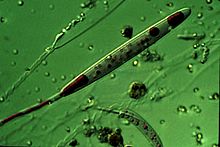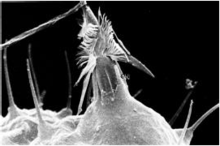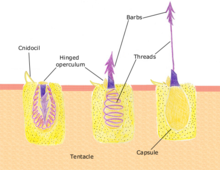- Cnidocyte
-
 Nomarski micrograph of a Ruthenium-red stained nematocyst from Aiptasia pallida, the pale anemone. The red dye stains the polyanionic venom proteins found inside the capsule of this partially discharged nematocyst.
Nomarski micrograph of a Ruthenium-red stained nematocyst from Aiptasia pallida, the pale anemone. The red dye stains the polyanionic venom proteins found inside the capsule of this partially discharged nematocyst.
A cnidocyte, cnidoblast, or nematocyte is a type of venomous cell unique to the phylum Cnidaria (corals, sea anemones, hydrae, jellyfish, etc.). The cnidocyte cell provides a means for them to catch prey and defend themselves from predators. Despite being morphologically simple, lacking a skeleton and usually being sessile, cnidarians prey on fish and crustaceans. A cnidocyte fires a structure that contains the toxin, from a characteristic sub-cellular organelle called a cnidocyst (also known as a cnida or nematocyst). This is responsible for the stings delivered by jellyfish.
Contents
Structure and action
Each cnidocyte cell contains an organelle called a cnidocyst (or nematocyst), which comprises a bulb-shape capsule containing a coiled hollow thread-like structure attached to it. The externally-oriented side of the cell also has a hair-like trigger called a cnidocil. When the trigger is activated, the shaft of the cnidocyst penetrates the target organism, and the hollow thread is everted into it. This discharge takes no more than a few microseconds, and is able to reach accelerations of about 40,000 g.[1] Recent research suggests the process to occur as fast as 700 nanoseconds, thus reaching an acceleration of up to 5,410,000 g.[2] After penetration, the toxic content of the nematocyst is injected into the target organism. The rapid activity of the injected neurotoxins immediately paralyzes the mobile prey, thus allowing the sessile cnidarian to devour it.
Discharge mechanism
The nematocyst capsule stores a large concentration of calcium ions, which are released from the capsule into the cytoplasm of the cnidocyte when the trigger is activated. This causes a large concentration gradient of calcium across the cnidocyte plasma membrane. The resulting osmotic pressure causes a rapid influx of water into the cell. This increase in water volume in the cytoplasm forces the coiled nematocyst to eject rapidly. The coiled nematocyst is a hollow tube that exists inside the cell in an "inside out" condition. The pressure of water flowing into the cnidocyte forces the water into the tubular nematocyst causing it to right itself as it comes rushing out of the cell with enough force to impale a prey organism.
Prey detection
A nematocyte is able under some conditions to fire independently, but this presents several problems for the cnidarian. First, it must avoid stinging itself. Second, it must replace cnidocytes after discharge, as they are "single use" cells, and this costs a lot of energy. In order to regulate discharge, cnidocytes are connected as "batteries", containing several types of nematocytes connected to supporting cells and neurons. The supporting cells contain chemosensors, which, together with the mechanoreceptor on the cnidocyte (cnidocil), allow only the right combination of stimuli to cause discharge, such as prey swimming, and chemicals found in prey cuticle or cuteous.
Types of nematocysts
Over 30 types of nematocytes are found in different cnidarians. They can be divided into the following groups:
- Penetrant: a harpoon-like structure used to penetrate, such as a nematocyst
- Glutinant: a sticky surface used to stick to prey
- Volvent: a lasso-like string that is fired at prey and wraps around a cellular projection on the prey, such as a spirocyst
- Ptychocyst: a special type of nematocyte found on burrowing (tube) anemones, which help create the tube in which the animal lives.
Depending on the species, one or several types can appear simultaneously on the organism.
Nematocyst toxicity
Nematocysts are very efficient weapons. A single nematocyst has been shown to suffice in paralyzing a small arthropod (Drosophila larva). The most deadly cnidocytes (to humans, at least) are found on the body of a box jellyfish.[3][4][5] One member of this family, the sea wasp, Chironex fleckeri, is "claimed to be the most venomous marine animal known," according to the Australian Institute of Marine Science. It causes excruciating pain to humans, often followed by death, sometimes within two or three minutes. The chance of survival if stung while swimming alone is "virtually zero." Other cnidarians, such as the jellyfish Cyanea capillata (the "Lion's Mane" made famous by Sherlock Holmes) or the hydrozoan Physalia physalis (Portuguese Man o' War, "Bluebottle") can cause extremely painful and sometimes fatal stings. On the other side, aggregating sea anemones may have the lowest sting intensity, perhaps due to the inability of the nematocysts to penetrate the skin, providing only a feeling of that similar to touching sticky candies to human fingers. Besides feeding and defense, sea anemone and coral colonies use cnidocytes to sting one another in order to defend or win space[citation needed].
Venom from animals such as cnidarians, scorpions and spiders may be species-specific. A substance that is weakly toxic for humans or other mammals may be strongly toxic to the natural prey or predators of the venomous animal. Such specificity has been used to create new medicines and bioinsecticides.
Animals in the phylum Ctenophora ("sea-gooseberries" or "comb jellies") are transparent and jelly-like but have no nematocysts, and are harmless to humans.
Certain types of sea slugs, such as the nudibranch aeolids, are known to undergo kleptocnidae (in addition to kleptoplasty), whereby the organisms store nematocysts of digested prey at the tips of their cerata.
References
- ^ G. Kass-Simon and A.A. Scappaticci, Jr. The behavioral and developmental physiology of nematocysts. Can. J. Zool. Vol. 80, 2002, pp 1772-1794
- ^ Underwatertimes.com News Service, Researchers: Nanosecond-scale release of stinging jellyfish nematocysts 'fastest cellular processes in nature' Retrieved 01-09-09.
- ^ Tibballs J (December 2006). "Australian venomous jellyfish, envenomation syndromes, toxins and therapy". Toxicon 48 (7): 830–59. doi:10.1016/j.toxicon.2006.07.020. PMID 16928389.
- ^ Brinkman D, Burnell J (November 2007). "Identification, cloning and sequencing of two major venom proteins from the box jellyfish, Chironex fleckeri". Toxicon 50 (6): 850–60. doi:10.1016/j.toxicon.2007.06.016. PMID 17688901.
- ^ Brinkman D, Burnell J (April 2008). "Partial purification of cytolytic venom proteins from the box jellyfish, Chironex fleckeri". Toxicon 51 (5): 853–63. doi:10.1016/j.toxicon.2007.12.017. PMID 18243272.
External links
- Dangerous marine animals of Northern Australia: the Sea Wasp Australian Institute of Marine Science; dangers of box jellyfish
- Nematocysts Firing Movie
- Wrobel, Dave. Nematocysts. JelliesZone. http://jellieszone.com/nematocysts.htm
Categories:- Animal cells
- Cnidarians
Wikimedia Foundation. 2010.


